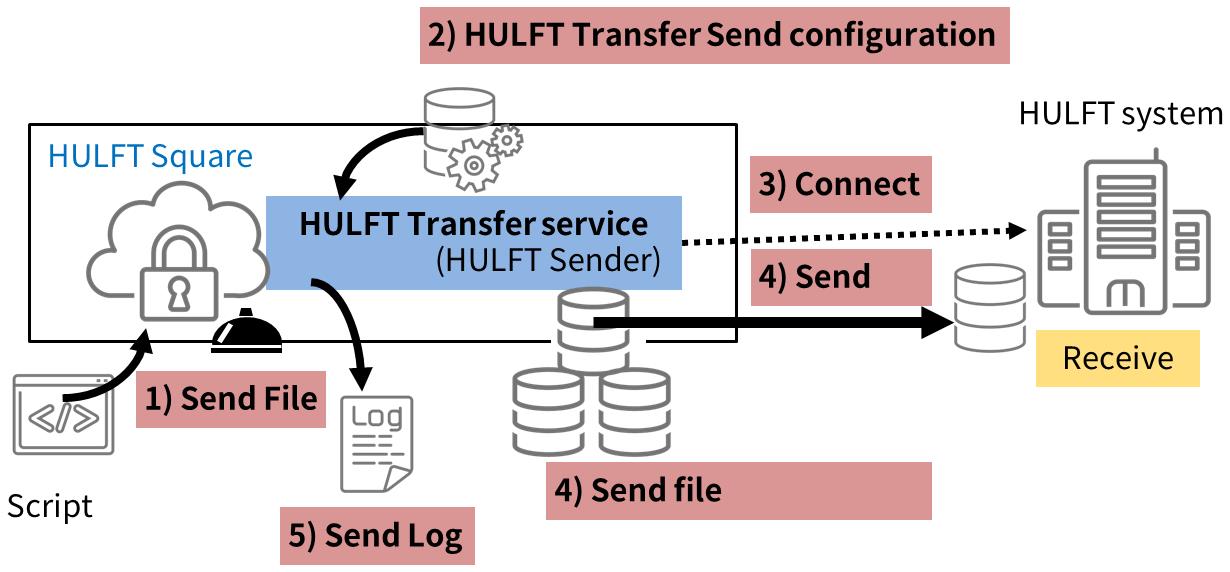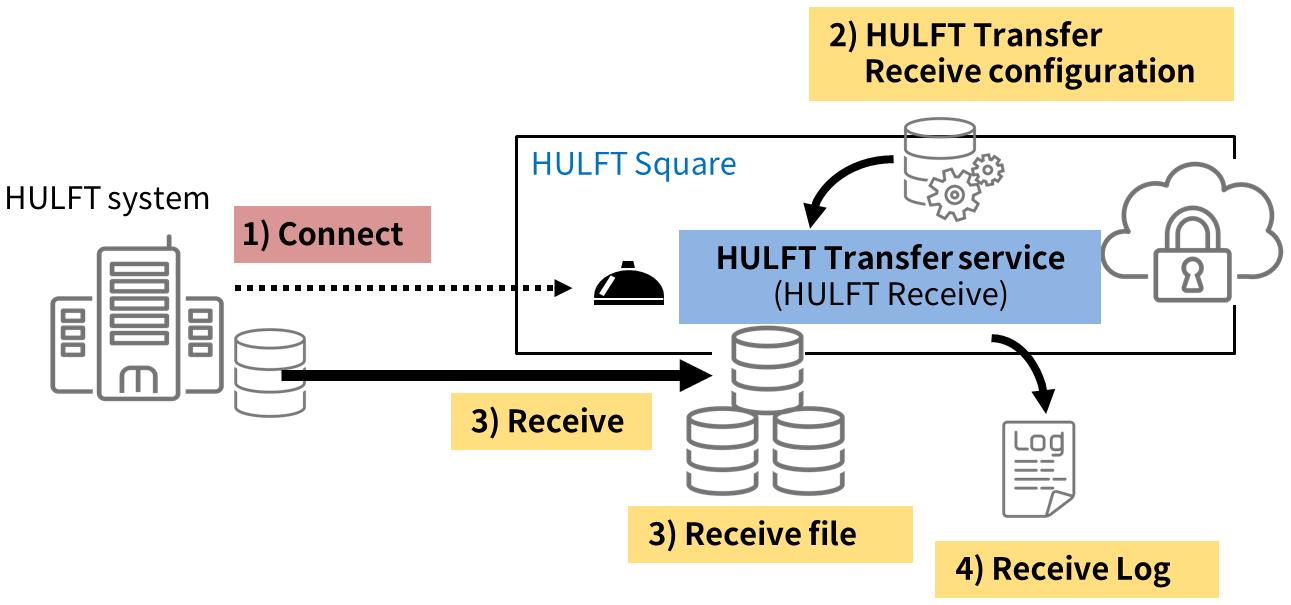HULFT Transfer service settings
System structure for HULFT Transfer services
For file transfers with HULFT Transfer services, sending a file is called "sending" and receiving a file is called "receiving." Following this logic, each of the systems for receiving and sending in file transfers with HULFT Transfer services are called:
|
System that sends files |
|
Sending-side host |
|
System that receives files |
|
Receiving-side host |
Also, when you transfer a file from your system to the destination system, these systems are differentiated as follows:
|
HULFT Square (HULFT Transfer services) |
|
Local host |
|
System that is the file transfer partner |
|
Remote host |
For example, if the local host is the sending-side host, the receiving-side host is the remote host. If the local host is the receiving-side host, the sending-side host is the remote host.

- Send
-
This is a function that transfers the files of the sending-side host to the receiving-side host according to the transfer settings information for sending. In this case, the files transferred from the sending-side host are called "send files."
- Receive
-
This is a function that receives the data sent by the sending-side host on the receiving-side host and creates files according to the transfer settings information for receiving. In this case, the files created by the receiving-side host are called "receive files."
- HULFT management information
-
The transfer settings information you need in order to operate the HULFT Transfer service is collectively called "HULFT management information."
Set the HULFT management information from the following menus in the navigation menu:
-
 > HULFT TRANSFER > Receive Config
> HULFT TRANSFER > Receive Config -
 > HULFT TRANSFER > Send Config
> HULFT TRANSFER > Send Config -
 > HULFT TRANSFER > Host Info
> HULFT TRANSFER > Host Info
For details on the HULFT management information, see Information managed by the HULFT Transfer service.
-
Prerequisites for file transfers
Check the following prerequisites for file transfers with the HULFT Transfer service:
- Host name
-
In file transfers with the HULFT Transfer service, the remote host is recognized by its "host name."
- Matching Transfer Name (file IDs)
-
For file transfers with the HULFT Transfer service, set and manage identification names (file IDs) to link the sending-side host and receiving-side host for each file transfer (for each file to transfer). The field name "file ID" in the on-premises HULFT system is called "Transfer Name" in the English version of HULFT Square.
Set the same value for the "Transfer Name" on both the sending-side host and receiving-side host.
The HULFT Transfer service executes transfers according to the settings for matching Transfer Names on the sending-side host and receiving-side host.
Information managed by the HULFT Transfer service
The transfer settings information you need in order to operate the HULFT Transfer service is collectively called "HULFT management information." For file transfers with the HULFT Transfer service, the HULFT management information that is used depends on whether the system is operating as the sending-side host or the receiving-side host.
|
HULFT management information |
Summary |
Receiving-side host |
Sending-side host |
|---|---|---|---|
|
HULFT Transfer Receive configurations |
Sets information such as the properties and transfer conditions for receive files. |
✓ |
None |
|
HULFT Transfer Send configurations |
Sets information such as the properties and transfer conditions for send files. |
None |
✓ |
|
HULFT Transfer Host configurations |
Sets the information for the remote host. |
✓ |
✓ |
|
HULFT Transfer Service Settings |
Sets the operating environment for the HULFT Transfer service and the required fields to execute the sending-side transferring and the receiving-side transferring. |
✓ |
✓ |
|
✓ |
: |
Used |
|
None |
: |
Not used |
Transfer logs
HULFT Transfer services manage the sending and receiving logs of HULFT Transfer.
You can check the transfer logs in the  menu of the navigation menu.
menu of the navigation menu.

Flow of the sending-side transferring
This is the sending-side transfer flow with the HULFT Transfer service.

-
Specify a Transfer Name and request sending by the HULFT Transfer service (HULFT Sender) of the sending-side host. This request is called "Send File."
Send File requests are issued from ETL scripts. HULFT Sender is the engine that executes the send function.
-
HULFT Sender reads the HULFT Transfer Send configuration.
-
HULFT Sender connects to the receiving-side host.
-
HULFT Sender directly reads the file to be sent and simultaneously transfers the data to the receiving-side host.
-
When the transfer finishes, HULFT Sender disconnects from the receiving-side host and writes the results of sending to the Send Log.
The Send Log is where you can check the history of file transfers on the sending-side host.
Flow of the receiving-side transferring
This is the receiving-side transfer flow with HULFT Transfer services.

-
The HULFT Transfer service (HULFT Receiver) of the receiving-side host accepts connections from the sending-side host.
HULFT Receiver is the engine that executes the receive function.
-
HULFT Receiver reads the HULFT Transfer Receive configuration based on the Transfer Name received from the sending-side host.
-
HULFT Receiver writes the data transferred from the sending-side host to receive files.
-
When the data transfer finishes, HULFT Receiver writes the results of receiving to the Receive Log.
The Receive Log is where you can check the history of file transfers on the receiving-side host.
Operational management, operational support, security
The following functions are available when you transfer files with the HULFT Transfer service:
- Operational management function
-
You can set the transfer information and the operational information needed for file transfers in the HULFT management information and the HULFT Transfer service settings.
Also, you can use HULFT Square functions such as monitoring and governance to view and output the transfer status and the transfer logs.
- Operational support function
-
You can use the data integration function on HULFT Square to create scripts and to integrate the sending-side transferring and the receiving-side transferring with business application jobs. Also, you can combine business operations before and after file transfers with transfer operations to execute streamlined processing without any manual operation.
- Security function
-
You can encrypt data when you transfer files. For the encryption scheme, you can use the AES encryption scheme. If the on-premises HULFT can't use the AES encryption scheme, the HULFT encryption scheme is applied.
= Remarks =By setting encryption keys for Transfer Send configurations and Transfer Receive configurations, you can encrypt file transfers.
For settings for encryption keys, refer to Receive Config and Send Config.
You can also check records of file access and records of operation. If you find a suspicious log or a strange value in the management information, you can determine who performed the operation that caused the log or who updated the information and when.